Spatial and Temporal Variations of Particulate Organic Carbon Sinking Flux in Global Ocean from 2003 to 2018
Abstract
1. Introduction
2. Materials and Methods
2.1. Remote Sensing Data
2.2. In Situ Data
2.3. POC Flux Estimation Models
2.4. Methods for Model Comparison
3. Results
3.1. Evaluation of POC Flux Estimation Models
3.2. Inversion Results of POC Flux
3.3. Spatial and Temporal Variations of POC Flux
3.3.1. Spatial Variation
3.3.2. Temporal Variation
4. Discussion
4.1. POC Flux in Continental Margins
4.2. Anomalies During the Annual Decreasing of POC Flux
4.3. Increasing Trend of POC Flux in High-Latitude Ocean
5. Conclusions
Author Contributions
Funding
Acknowledgments
Conflicts of Interest
References
- Siegenthaler, U.; Sarmiento, J.L. Atmospheric carbon dioxide and the ocean. Nature 1993, 365, 119–125. [Google Scholar] [CrossRef]
- Allison, D.B.; Stramski, D.; Mitchell, B.G. Seasonal and interannual variability of particulate organic carbon within the Southern Ocean from satellite ocean color observations. J. Geophys. Res. 2010, 115. [Google Scholar] [CrossRef]
- Gómez-Robles, A. Hidden trends in the ocean carbon sink. Nature 2016, 530, 426–427. [Google Scholar]
- Falkowski, P.G.; Barber, R.T.; Smetacek, V. Biogeochemical controls and feedbacks on ocean primary production. Science 1998, 281, 200–206. [Google Scholar] [CrossRef] [PubMed]
- Sabine, C.L.; Feely, R.A.; Gruber, N.; Key, R.M.; Lee, K.; Bullister, J.L.; Wanninkhof, R.; Wong, C.; Wallace, D.W.; Tilbrook, B. The oceanic sink for anthropogenic CO2. Science 2004, 305, 367–371. [Google Scholar] [CrossRef] [PubMed]
- Turner, J.T. Zooplankton fecal pellets, marine snow, phytodetritus and the ocean’s biological pump. Prog. Oceanogr. 2015, 130, 205–248. [Google Scholar] [CrossRef]
- Manizza, M.; Buitenhuis, E.T.; Le Quéré, C. Sensitivity of global ocean biogeochemical dynamics to ecosystem structure in a future climate. Geophys. Res. Lett. 2010, 37. [Google Scholar] [CrossRef]
- Lima, I.D.; Lam, P.J.; Doney, S.C. Dynamics of particulate organic carbon flux in a global ocean model. Biogeosciences 2014, 11, 1177–1198. [Google Scholar] [CrossRef]
- Steinacher, M.; Joos, F.; Frölicher, T.; Bopp, L.; Cadule, P.; Cocco, V.; Doney, S.C.; Gehlen, M.; Lindsay, K.; Moore, J.K. Projected 21st century decrease in marine productivity: A multi-model analysis. Biogeosciences 2010, 7, 979–1005. [Google Scholar] [CrossRef]
- Henson, S.A.; Sanders, R.; Madsen, E.; Morris, P.J.; Le Moigne, F.; Quartly, G.D. A reduced estimate of the strength of the ocean’s biological carbon pump. Geophys. Res. Lett. 2011, 38. [Google Scholar] [CrossRef]
- Ducklow, H.W.; Steinberg, D.K.; Buesseler, K.O. Upper ocean carbon export and the biological pump. Oceanogr. Wash. DC Oceanogr. Soc. 2001, 14, 50–58. [Google Scholar] [CrossRef]
- Chisholm, S.W. Oceanography: Stirring times in the Southern Ocean. Nature 2000, 407, 685. [Google Scholar] [CrossRef] [PubMed]
- Gardner, W. Sediment Trap Sampling in Surface Waters; Cambridge University Press: Cambridge, UK, 2000. [Google Scholar]
- Loeff, D.; Van, M.R.; Pinghe, H.; Stimac, I.; Bracher, A.; Middag, R. 234Th in surface waters: Distribution of particle export flux across the Antarctic Circumpolar Current and in the Weddell Sea during the GEOTRACES expedition ZERO and DRAKE. Deep Sea Res. Part II Top. Stud. Oceanogr. 2011, 58, 2749–2766. [Google Scholar] [CrossRef]
- Anand, S.S.; Rengarajan, R.; Shenoy, D.; Gauns, M.; Naqvi, S. POC export fluxes in the Arabian Sea and the Bay of Bengal: A simultaneous 234Th/238U and 210Po/210Pb study. Mar. Chem. 2018, 198, 70–87. [Google Scholar] [CrossRef]
- Choi, M.S. Estimation of POC Export Fluxes Using 234Th/238U Disequilibrium in the Amundsen Sea, Antarctic V; Chungnam National University: Daejeon, Korea, 2017. [Google Scholar]
- Kim, H.J.; Kim, J.; Kim, D.; Chandler, M.T.; Son, S.K. Sinking Particle Flux in the Subtropical Oligotrophic Northwestern Pacific from a Short-term Sediment. Trap Experiment. Ocean Sci. J. 2018, 53, 395–403. [Google Scholar] [CrossRef]
- Subha Anand, S.; Rengarajan, R.; Sarma, V.V.S.S. 234Th-Based Carbon Export Flux Along the Indian GEOTRACES GI02 Section in the Arabian Sea and the Indian Ocean. Glob. Biogeochem. Cycles 2018, 32, 417–436. [Google Scholar] [CrossRef]
- Torres-Valdés, S.; Painter, S.C.; Martin, A.P.; Sanders, R.; Felden, J. Fluxes of sedimenting material from sediment traps in the Atlantic Ocean. Earth Syst. Sci. Data Discuss. 2013, 6, 541–595. [Google Scholar] [CrossRef]
- Fan, H.; Wang, X.; Zhang, H.; Yu, Z. Spatial and temporal variations of particulate organic carbon in the Yellow-Bohai Sea over 2002–2016. Sci. Rep. 2018, 8, 7971. [Google Scholar] [CrossRef]
- Gloege, L.; Mckinley, G.A.; Mouw, C.B.; Ciochetto, A.B. Global Evaluation of Particulate Organic Carbon Flux Parameterizations and Implications for Atmospheric pCO2: Evaluating POC Flux Parameterizations. Glob. Biogeochem. Cycles 2017, 31, 1192–1215. [Google Scholar] [CrossRef]
- Buesseler, K.O.; Boyd, P.W. Shedding light on processes that control particle export and flux attenuation in the twilight zone of the open ocean. Limnol. Oceanogr. 2009, 54, 1210–1232. [Google Scholar] [CrossRef]
- Eppley, R.W.; Peterson, B.J. Particulate organic matter flux and planktonic new production in the deep ocean. Nature 1979, 282, 677–680. [Google Scholar] [CrossRef]
- Baines, S.B.; Karl, P.D.M. Why Does the Relationship Between Sinking Flux and Planktonic Primary Production Differ. Between Lakes and Oceans? Limnol. Oceanogr. 1994, 39, 213–226. [Google Scholar] [CrossRef]
- Dunne, J.P.; Armstrong, R.A.; Gnanadesikan, A.; Sarmiento, J.L. Empirical and mechanistic models for the particle export ratio. Glob. Biogeochem. Cycles 2005, 19. [Google Scholar] [CrossRef]
- Laws, E.A.; Falkowski, P.G.; Smith, W.O.; Ducklow, H.; McCarthy, J.J. Temperature effects on export production in the open ocean. Glob. Biogeochem. Cycles 2000, 14, 1231–1246. [Google Scholar] [CrossRef]
- Laws, E.A.; D’Sa, E.; Naik, P. Simple equations to estimate ratios of new or export production to total production from satellite-derived estimates of sea surface temperature and primary production. Limnol. Oceanogr. Methods 2011, 9, 593–601. [Google Scholar] [CrossRef]
- Dunne, J.P.; Sarmiento, J.L.; Gnanadesikan, A. A synthesis of global particle export from the surface ocean and cycling through the ocean interior and on the seafloor. Glob. Biogeochem. Cycles 2007, 21. [Google Scholar] [CrossRef]
- Lutz, M.J.; Caldeira, K.; Dunbar, R.B.; Behrenfeld, M.J.; Lutz, C. Seasonal rhythms of net primary production and particulate organic carbon flux to depth describe the efficiency of biological pump in the global ocean. J. Geophys. Res. Ocean 2007, 112. [Google Scholar] [CrossRef]
- Świrgoń, M.; Stramska, M. Comparison of in situ and satellite ocean color determinations of particulate organic carbon concentration in the global ocean. Oceanologia 2015, 57, 25–31. [Google Scholar] [CrossRef]
- Yu, J.; Wang, X.; Fan, H.; Zhang, R.-H. impacts of physical and Biological processes on Spatial and temporal Variability of particulate organic Carbon in the North. Pacific Ocean. during 2003–2017. Sci. Rep. 2019, 9, 1–15. [Google Scholar] [CrossRef]
- Stramska, M.; Bialogrodzka, J. Satellite observations of seasonal and regional variability of particulate organic carbon concentration in the Barents Sea. Oceanologia 2016, 58, 249–263. [Google Scholar] [CrossRef]
- Rixen, T.; Gaye, B.; Emeis, K.-C.; Ramaswamy, V. The ballast effect of lithogenic matter and its influences on the carbon fluxes in the Indian Ocean. Biogeosciences 2019, 16, 485–503. [Google Scholar] [CrossRef]
- Bopp, L.; Monfray, P.; Aumont, O.; Dufresne, J.L.; Le Treut, H.; Madec, G.; Terray, L.; Orr, J.C. Potential impact of climate change on marine export production. Glob. Biogeochem. Cycles 2001, 15, 81–99. [Google Scholar] [CrossRef]
- Bopp, L.; Aumont, O.; Cadule, P.; Alvain, S.; Gehlen, M. Response of diatoms distribution to global warming and potential implications: A global model study. Geophys. Res. Lett. 2005, 32. [Google Scholar] [CrossRef]
- Marinov, I.; Doney, S.C.; Lima, I.D.; Lindsay, K.; Moore, J.K.; Mahowald, N. North.-South. asymmetry in the modeled phytoplankton community response to climate change over the 21st century. Glob. Biogeochem. Cycles 2013, 27, 1274–1290. [Google Scholar] [CrossRef]
- Stramska, M.; Cieszyńska, A. Ocean. colour estimates of particulate organic carbon reservoirs in the global ocean–revisited. Int. J. Remote Sens. 2015, 36, 3675–3700. [Google Scholar] [CrossRef]
- Behrenfeld, M.J.; Falkowski, P.G. A consumer′s guide to phytoplankton primary productivity models. Limnol. Oceanogr. 1997, 42, 1479–1491. [Google Scholar] [CrossRef]
- Behrenfeld, M.J.; Boss, E.; Siegel, D.A.; Shea, D.M. Carbon-based ocean productivity and phytoplankton physiology from space. Glob. Biogeochem. Cycles 2005, 19. [Google Scholar] [CrossRef]
- Tao, Z.; Yan, W.; Sheng, M.; Lv, T.; Xiang, Z. A Phytoplankton Class-Specific Marine Primary Productivity Model Using MODIS Data. IEEE J. Sel. Top. Appl. Earth Obs. Remote Sens. 2017, 10, 5519–5528. [Google Scholar] [CrossRef]
- Hung, C.C.; Tseng, C.W.; Gong, G.C.; Chen, K.S.; Chen, M.H.; Hsu, S.C. Fluxes of particulate organic carbon in the East China Sea in summer. Biogeosciences 2013, 10, 6469–6484. [Google Scholar] [CrossRef]
- Hung, C.-C.; Chen, Y.-F.; Hsu, S.-C.; Wang, K.; Chen, J.F.; Burdige, D.J. Using rare earth elements to constrain particulate organic carbon flux in the East China Sea. Sci. Rep. 2016, 6, 33880. [Google Scholar] [CrossRef]
- Sallon, A.; Michel, C.; Gosselin, M. Summertime primary production and carbon export in the southeastern Beaufort Sea during the low ice year of 2008. Polar Biol. 2011, 34, 1989–2005. [Google Scholar] [CrossRef]
- Martin, J.H.; Knauer, G.A.; Karl, D.M.; Broenkow, W.W. VERTEX: Carbon cycling in the northeast Pacific. Deep Sea Res. Part A Oceanogr. Res. Pap. 1987, 34, 267–285. [Google Scholar] [CrossRef]
- Armstrong, R.A.; Lee, C.; Honjo, J.I.; Honjo, S.; Wakeham, S.G. A new, mechanistic model for organic carbon fluxes in the ocean based on the quantitative association of POC with ballast minerals. Deep Sea Res. Part II 2002, 49, 219–236. [Google Scholar] [CrossRef]
- Stramska, M. Particulate organic carbon in the global ocean derived from SeaWiFS ocean color. Deep Sea Res. Part I Oceanogr. Res. Pap. 2009, 56, 1459–1470. [Google Scholar] [CrossRef]
- Duforêt-Gaurier, L.; Loisel, H.; Dessailly, D.; Nordkvist, K.; Alvain, S. Estimates of particulate organic carbon over the euphotic depth from in situ measurements. Application to satellite data over the global ocean. Deep Sea Res. Part I Oceanogr. Res. Pap. 2010, 57, 351–367. [Google Scholar] [CrossRef]
- Pan, D.; Liu, Q.; Bai, Y. Review and suggestions for estimating particulate organic carbon and dissolved organic carbon inventories in the ocean using remote sensing data. Acta Oceanol. Sin. 2014, 33, 1–10. [Google Scholar] [CrossRef]
- Balch, W.M.; Bowler, B.C.; Drapeau, D.T.; Lubelczyk, L.C.; Lyczkowski, E. Vertical Distributions of Coccolithophores, PIC, POC, Biogenic Silica, and Chlorophyll a Throughout the Global Ocean. Glob. Biogeochem. Cycles 2018, 32, 2–17. [Google Scholar] [CrossRef]
- Friedrichs, M.; Carr, M.; Barber, R.; Scardi, M.; Antoine, D.; Armstrong, R.; Asanuma, I.; Behrenfeld, M.; Buitenhuis, E.; Chai, F. Assessing the uncertainties of model estimates of primary productivity in the tropical Pacific Ocean. J. Mar. Syst. 2009, 76, 113–133. [Google Scholar] [CrossRef]
- Dugdale, R.C.; Goering, J.J. Uptake of New and Regenerated Forms of Nitrogen in Primary Productivity. Limnol. Oceanogr. 1967, 12, 196–206. [Google Scholar] [CrossRef]
- Henson, S.A.; Yool, A.; Sanders, R. Variability in efficiency of particulate organic carbon export: A model study. Glob. Biogeochem. Cycles 2015, 29, 33–45. [Google Scholar] [CrossRef]
- Laufkötter, C.; Vogt, M.; Gruber, N.; Aumont, O.; Bopp, L.; Doney, S.C.; Dunne, J.P.; Hauck, J.; John, J.G.; Lima, I.D. Projected decreases in future marine export production: The role of the carbon flux through the upper ocean ecosystem. Biogeosciences 2016, 13, 4023–4047. [Google Scholar] [CrossRef]
- Liu, K.; Iseki, K.; Chao, S. Continental margin carbon fluxes. In The Changing Ocean Carbon Cycle: A Midterm Synthesis of the Joint Global Ocean Flux Study; Hanson, R.B., Ducklow, H.W., Field, J.G., Eds.; Cambridge University Press: Cambridge, UK, 2000; pp. 187–239. [Google Scholar]
- Muller-Karger, F.E.; Varela, R.; Thunell, R.; Luerssen, R.; Hu, C.; Walsh, J.J. The importance of continental margins in the global carbon cycle. Geophys. Res. Lett. 2005, 32. [Google Scholar] [CrossRef]
- Liu, K.-K.; Atkinson, L.; Chen, C.T.A.; Gao, S.; Hall, J.; MacDonald, R.W.; McManus, L.T.; Quiñones, R. Exploring continental margin carbon fluxes on a global scale. Eos Trans. Am. Geophys. Union 2000, 81, 641–644. [Google Scholar] [CrossRef]
- Boyd, P.W.; Trull, T.W. Understanding the export of biogenic particles in oceanic waters: Is there consensus? Prog. Oceanogr. 2007, 72, 276–312. [Google Scholar] [CrossRef]
- De Haas, H.; Van Weering, T.C.E.; De Stigter, H. Organic carbon in shelf seas: Sinks or sources, processes and products. Cont. Shelf Res. 2002, 22, 691–717. [Google Scholar] [CrossRef]
- Liu, D.; Bai, Y.; He, X.; Tao, B.; Pan, D.; Chen, C.-T.A.; Zhang, L.; Xu, Y.; Gong, C. Satellite estimation of particulate organic carbon flux from Changjiang River to the estuary. Remote Sens. Environ. 2019, 223, 307–319. [Google Scholar] [CrossRef]
- Le, C.; Lehrter, J.C.; Hu, C.; MacIntyre, H.; Beck, M.W. Satellite observation of particulate organic carbon dynamics on the Louisiana continental shelf. J. Geophys. Res. Ocean. 2017, 122, 555–569. [Google Scholar] [CrossRef]
- Son, Y.B.; Gardner, W.D.; Mishonov, A.V.; Richardson, M.J. Multispectral remote-sensing algorithms for particulate organic carbon (POC): The Gulf of Mexico. Remote Sens. Environ. 2009, 113, 50–61. [Google Scholar] [CrossRef]
- Liu, D.; Pan, D.; Yan, B.; He, X.; Wang, D.; Wei, J.-A.; Zhang, L. Remote Sensing Observation of Particulate Organic Carbon in the Pearl River Estuary. Remote Sens. 2015, 7, 8683–8704. [Google Scholar] [CrossRef]
- Anand, S.S.; Rengarajan, R.; Sarma, V.; Sudheer, A.; Bhushan, R.; Singh, S. Spatial variability of upper ocean POC export in the Bay of Bengal and the Indian Ocean determined using particle-reactive 234Th. J Geophys. Res. Ocean. 2017, 122, 3753–3770. [Google Scholar] [CrossRef]
- Wakelin, S.; Holt, J.; Blackford, J.; Allen, J.; Butenschön, M.; Artioli, Y. Modeling the carbon fluxes of the northwest European continental shelf: Validation and budgets. J. Geophys. Res. Ocean. 2012, 117. [Google Scholar] [CrossRef]
- Diesing, M.; Kröger, S.; Parker, R.; Jenkins, C.; Mason, C.; Weston, K. Predicting the standing stock of organic carbon in surface sediments of the North–West European continental shelf. Biogeochemistry 2017, 135, 183–200. [Google Scholar] [CrossRef]
- McPhaden, M.J. Genesis and Evolution of the 1997–98 El Nino. Science 1999, 283, 950–954. [Google Scholar] [CrossRef] [PubMed]
- Strutton, P.G.; Chavez, F.P. Primary productivity in the equatorial Pacific during the 1997–1998 El Niño. J. Geophys. Res. Ocean. 2000, 105, 26089–26101. [Google Scholar] [CrossRef]
- Iriarte, J.L.; González, H.E. Phytoplankton size structure during and after the 1997/98 El Niño in a coastal upwelling area of the northern Humboldt Current System. Mar. Ecol. Prog. Ser. 2004, 269, 83–90. [Google Scholar] [CrossRef]
- González, H.E.; Sobarzo, M.; Figueroa, D.; Nöthig, E.-M. Composition, biomass and potential grazing impact of the crustacean and pelagic tunicates in the northern Humboldt Current area off Chile: Differences between El Niño and non-El Niño years. Mar. Ecol. Prog. Ser. 2000, 195, 201–220. [Google Scholar] [CrossRef]
- Behrenfeld, M.J.; O′Malley, R.T.; Siegel, D.A.; Mcclain, C.R.; Sarmiento, J.L.; Feldman, G.C.; Milligan, A.J.; Falkowski, P.G.; Letelier, R.M.; Boss, E.S. Climate-driven trends in contemporary ocean productivity. Nature 2006, 444, 752–755. [Google Scholar] [CrossRef]
- Fagan, A.J.; Moreno, A.R.; Martiny, A.C. Role of ENSO Conditions on Particulate Organic Matter Concentrations and Elemental Ratios in the Southern California Bight. Front. Mar. Sci. 2019, 6. [Google Scholar] [CrossRef]
- Kawahata, H.; Gupta, L.P. Settling particles flux in response to El Nino/Southern Oscillation (ENSO) in the equatorial Pacific. In Global Environmental Change in the Ocean and on Land; Terrapub: Tokyo, Japan, 2004; pp. 95–108. [Google Scholar]
- La, H.S.; Park, K.; Wåhlin, A.; Arrigo, K.R.; Kim, D.S.; Yang, E.J.; Atkinson, A.; Fielding, S.; Im, J.; Kim, T.-W. Zooplankton and micronekton respond to climate fluctuations in the Amundsen Sea polynya, Antarctica. Sci. Rep. 2019, 9, 1–7. [Google Scholar] [CrossRef]
- Lipsen, M.S.; Crawford, D.W.; Gower, J.; Harrison, P.J. Spatial and temporal variability in coccolithophore abundance and production of PIC and POC in the NE subarctic Pacific during El Niño (1998), La Niña (1999) and 2000. Prog. Oceanogr. 2007, 75, 304–325. [Google Scholar] [CrossRef]
- Taucher, J.; Oschlies, A. Can we predict the direction of marine primary production change under global warming? Geophys. Res. Lett. 2011, 38. [Google Scholar] [CrossRef]
- Dutkiewicz, S.; Scott, J.R.; Follows, M. Winners and losers: Ecological and biogeochemical changes in a warming ocean. Glob. Biogeochem. Cycles 2013, 27, 463–477. [Google Scholar] [CrossRef]
- Laufkötter, C.; Vogt, M.; Gruber, N.; Aita-Noguchi, M.; Aumont, O.; Bopp, L.; Buitenhuis, E.; Doney, S.; Dunne, J.; Hashioka, T. Drivers and uncertainties of future global marine primary production in marine ecosystem models. Biogeosciences 2015, 12, 6955–6984. [Google Scholar] [CrossRef]
- Takahashi, T.; Sutherland, S.C.; Sweeney, C.; Poisson, A.; Metzl, N.; Tilbrook, B.; Bates, N.; Wanninkhof, R.; Feely, R.A.; Sabine, C. Global sea–air CO2 flux based on climatological surface ocean p CO2, and seasonal biological and temperature effects. Deep Sea Res. Part II 2002, 49, 1601–1622. [Google Scholar] [CrossRef]
- Takahashi, T.; Sutherland, S.C.; Wanninkhof, R.; Sweeney, C.; Feely, R.A.; Chipman, D.W.; Hales, B.; Friederich, G.; Chavez, F.; Sabine, C.; et al. Climatological mean and decadal change in surface ocean pCO2, and net sea–air CO2 flux over the global oceans. Deep Sea Res. Part II Top. Stud. Oceanogr. 2009, 56, 554–577. [Google Scholar] [CrossRef]
- Arrigo, K.R.; Van Dijken, G.L. Secular trends in Arctic Ocean net primary production. J. Geophys. Res. Ocean. 2011, 116. [Google Scholar] [CrossRef]
- Arrigo, K.R.; Van Dijken, G.L. Continued increases in Arctic Ocean primary production. Prog. Oceanogr. 2015, 136, 60–70. [Google Scholar] [CrossRef]
- Li, H.; Ke, C.; Zhu, Q.; Shu, S. Spatial-temporal variations in net primary productivity in the Arctic from 2003 to 2016. Acta Oceanol. Sin. 2019, 38, 111–121. [Google Scholar] [CrossRef]
- Stroeve, J.C.; Serreze, M.C.; Holland, M.M.; Kay, J.E.; Malanik, J.; Barrett, A.P. The Arctic’s rapidly shrinking sea ice cover: A research synthesis. Clim. Chang. 2012, 110, 1005–1027. [Google Scholar] [CrossRef]
- Onarheim, I.H.; Eldevik, T.; Smedsrud, L.H.; Stroeve, J.C. Seasonal and regional manifestation of Arctic sea ice loss. J. Clim. 2018, 31, 4917–4932. [Google Scholar] [CrossRef]
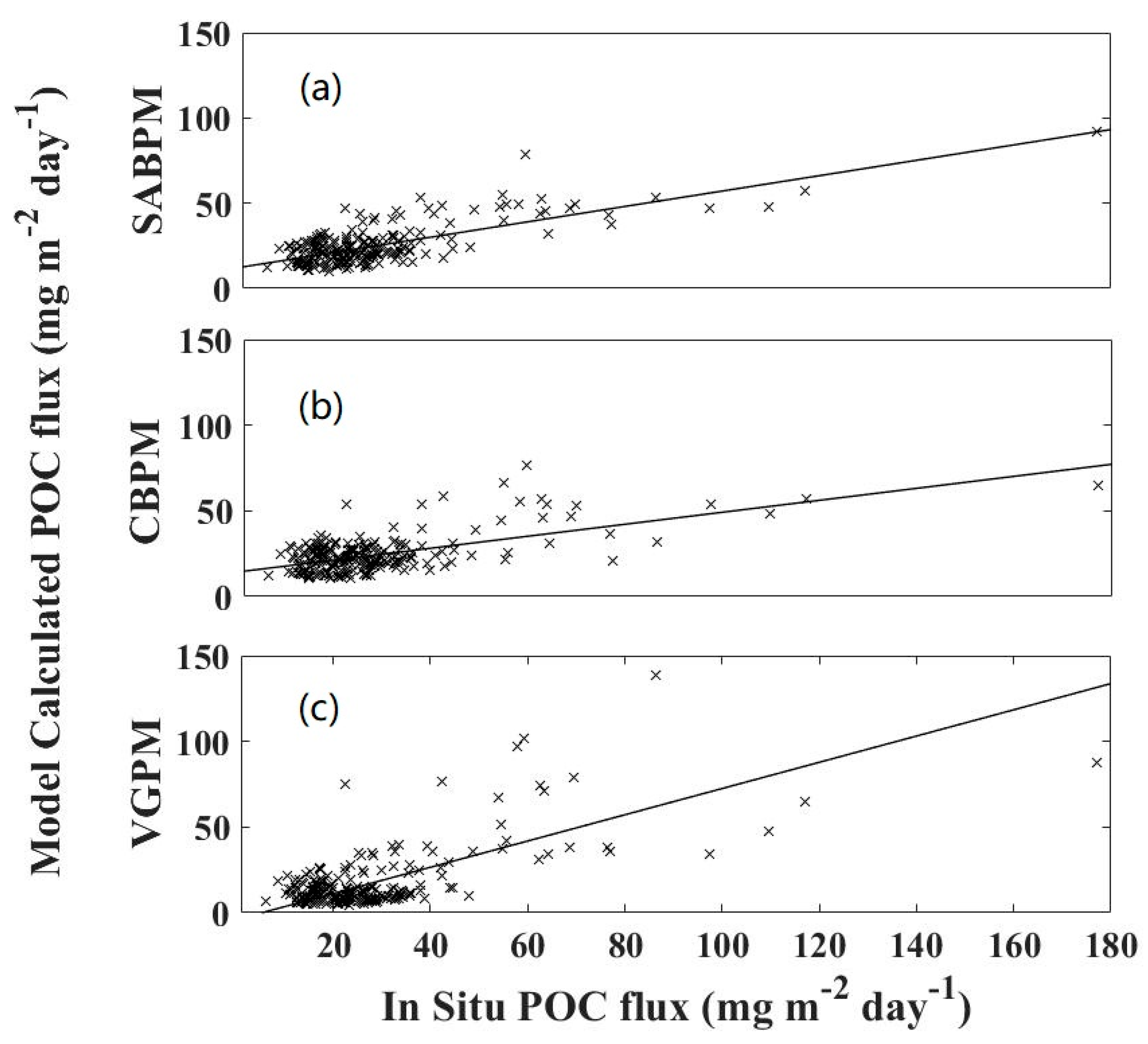
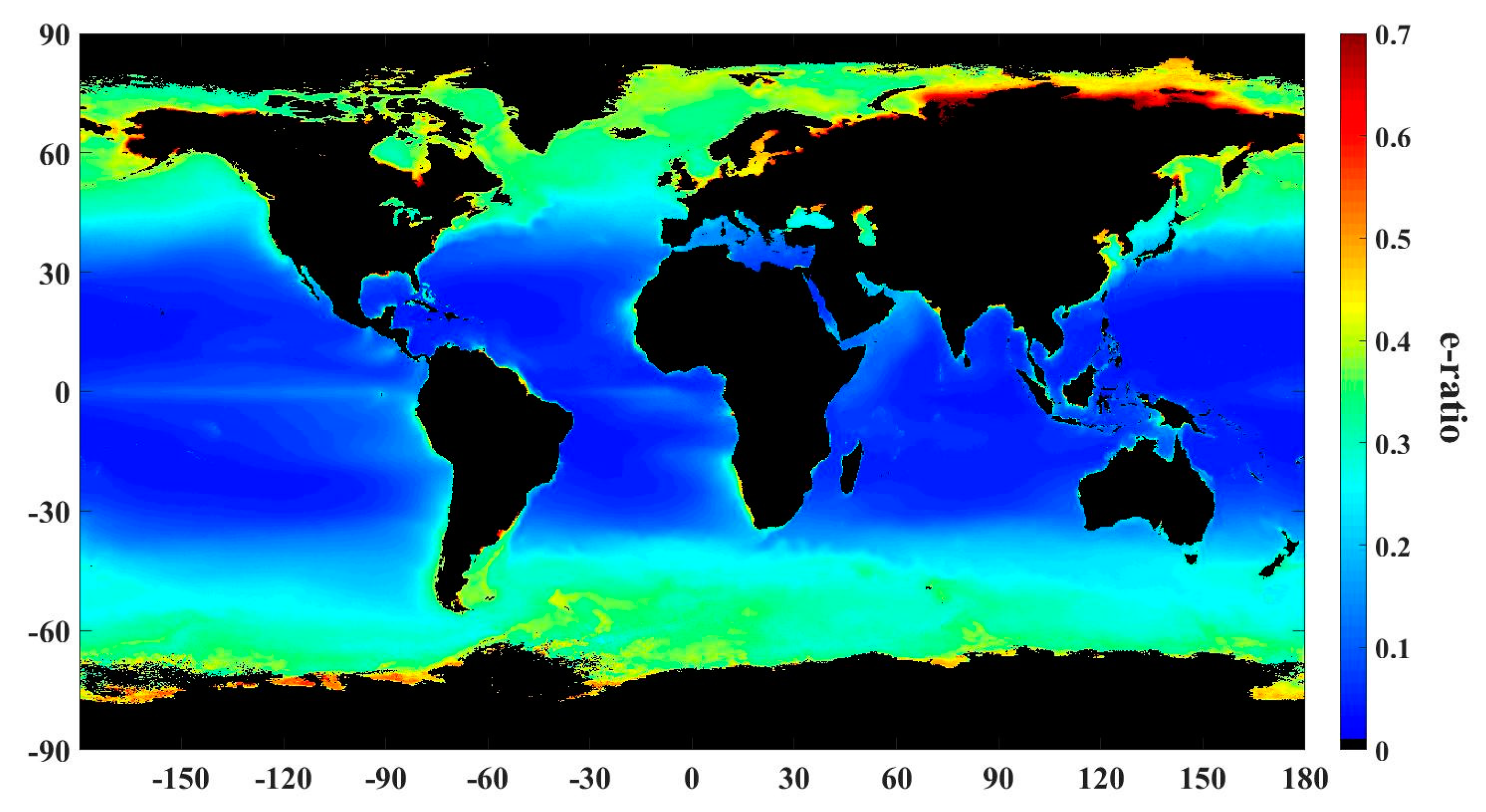

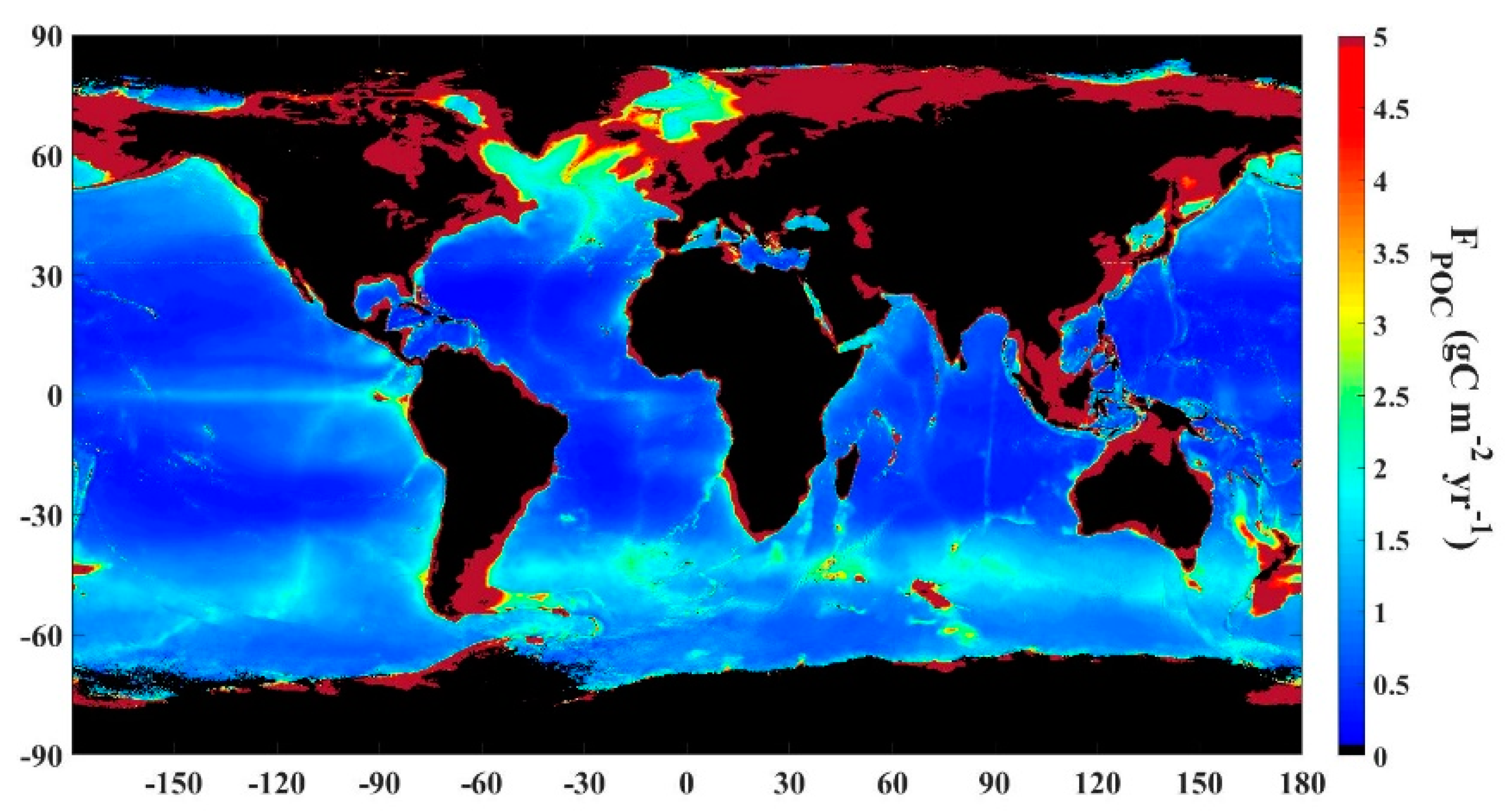

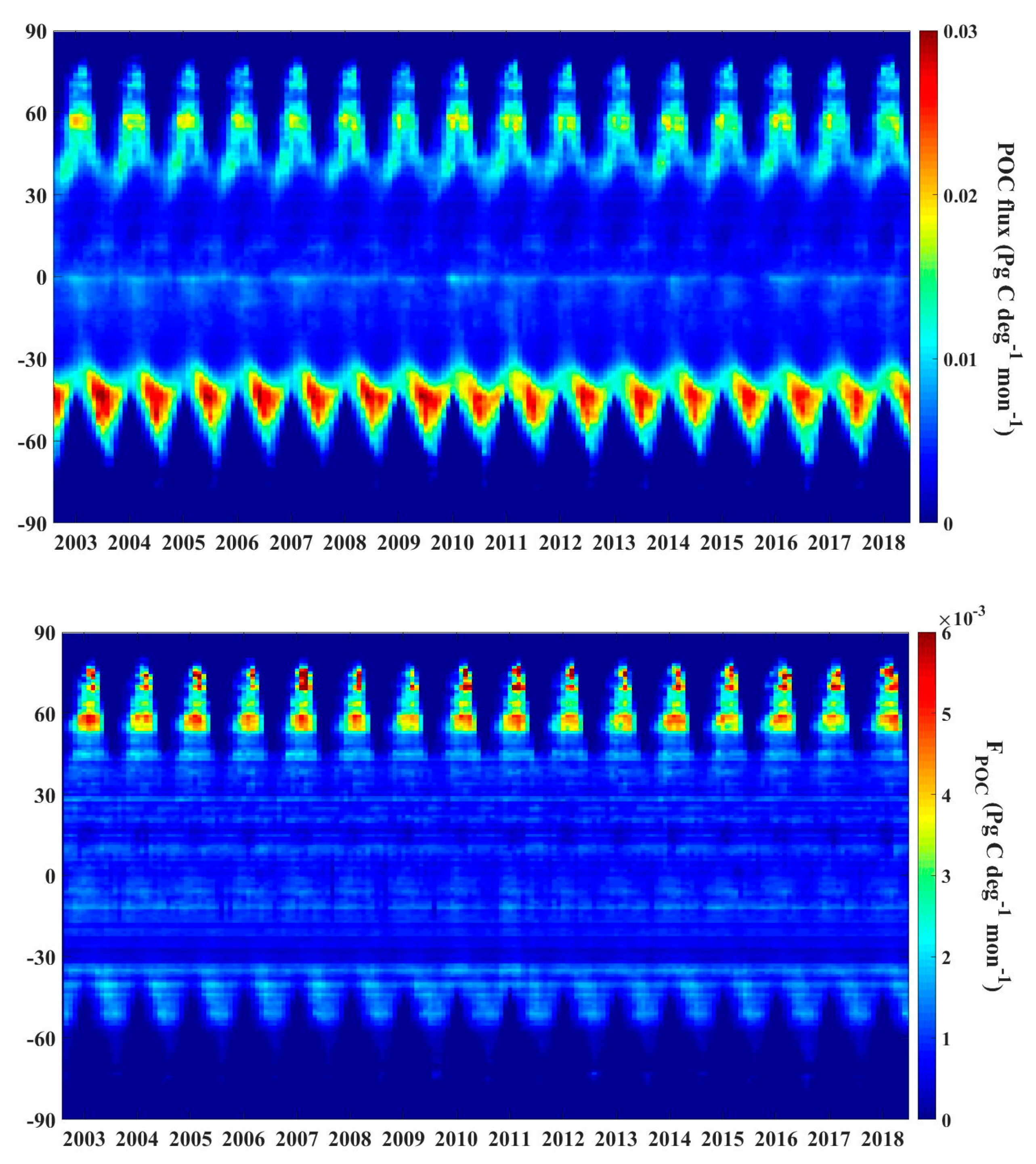
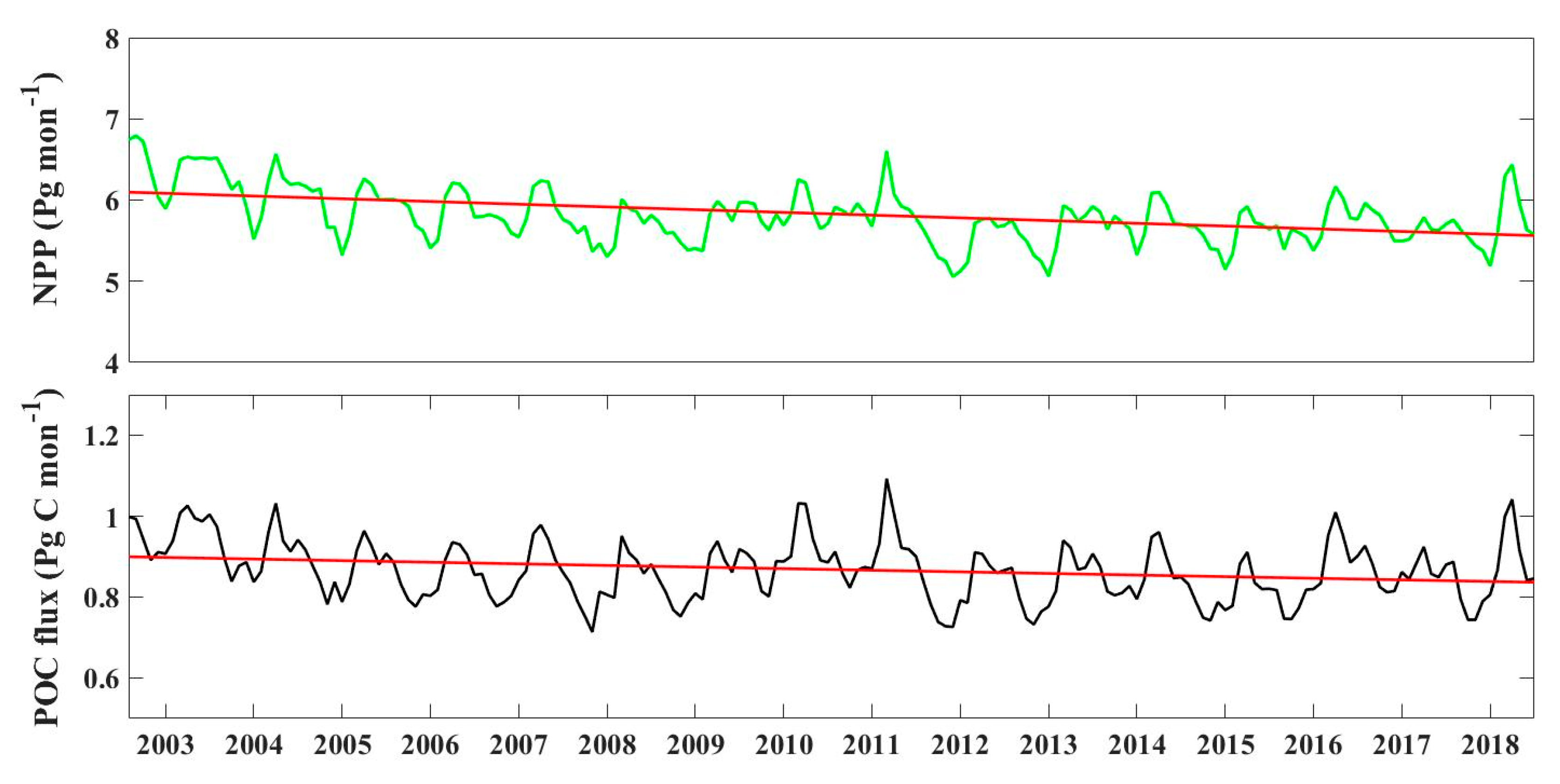

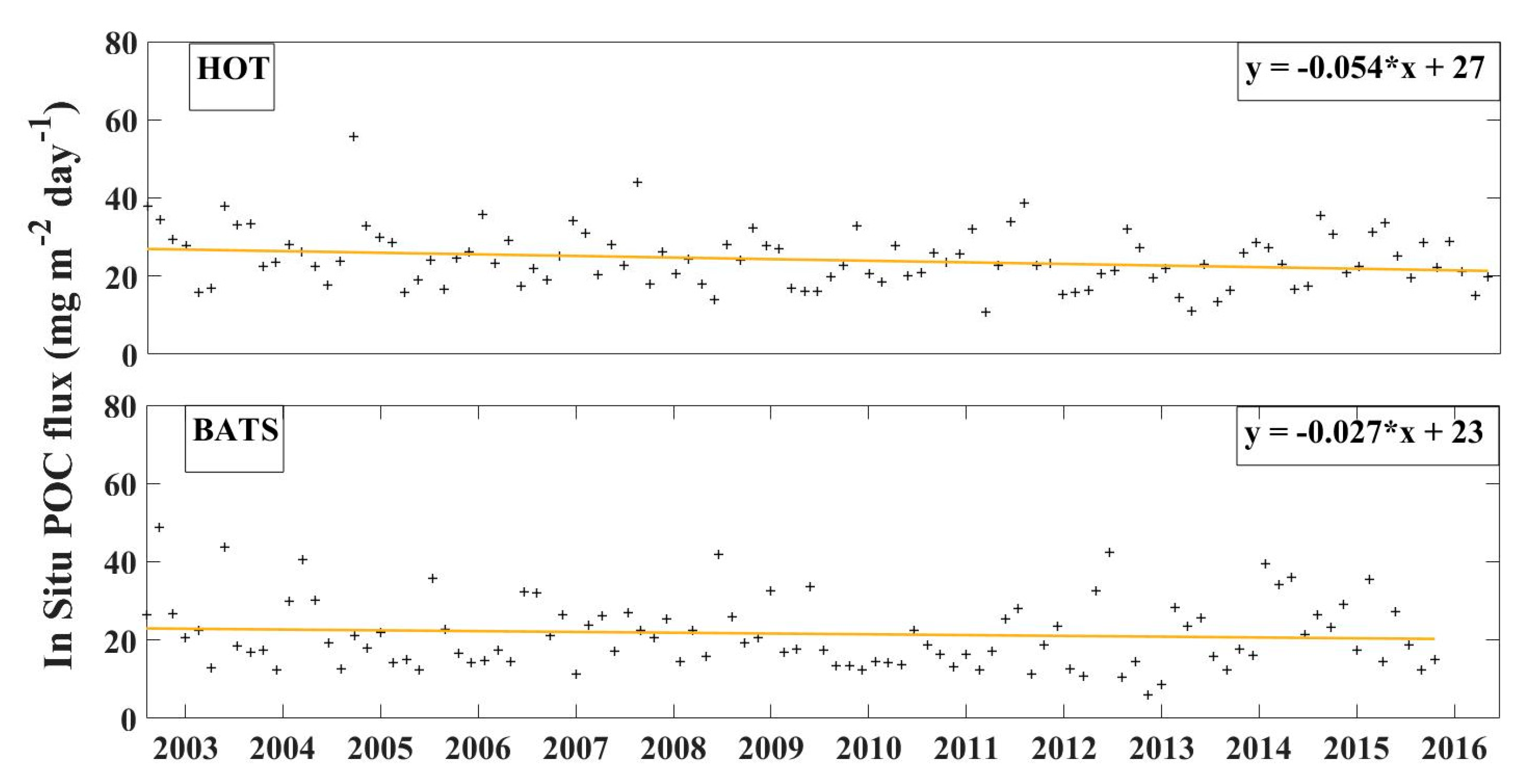
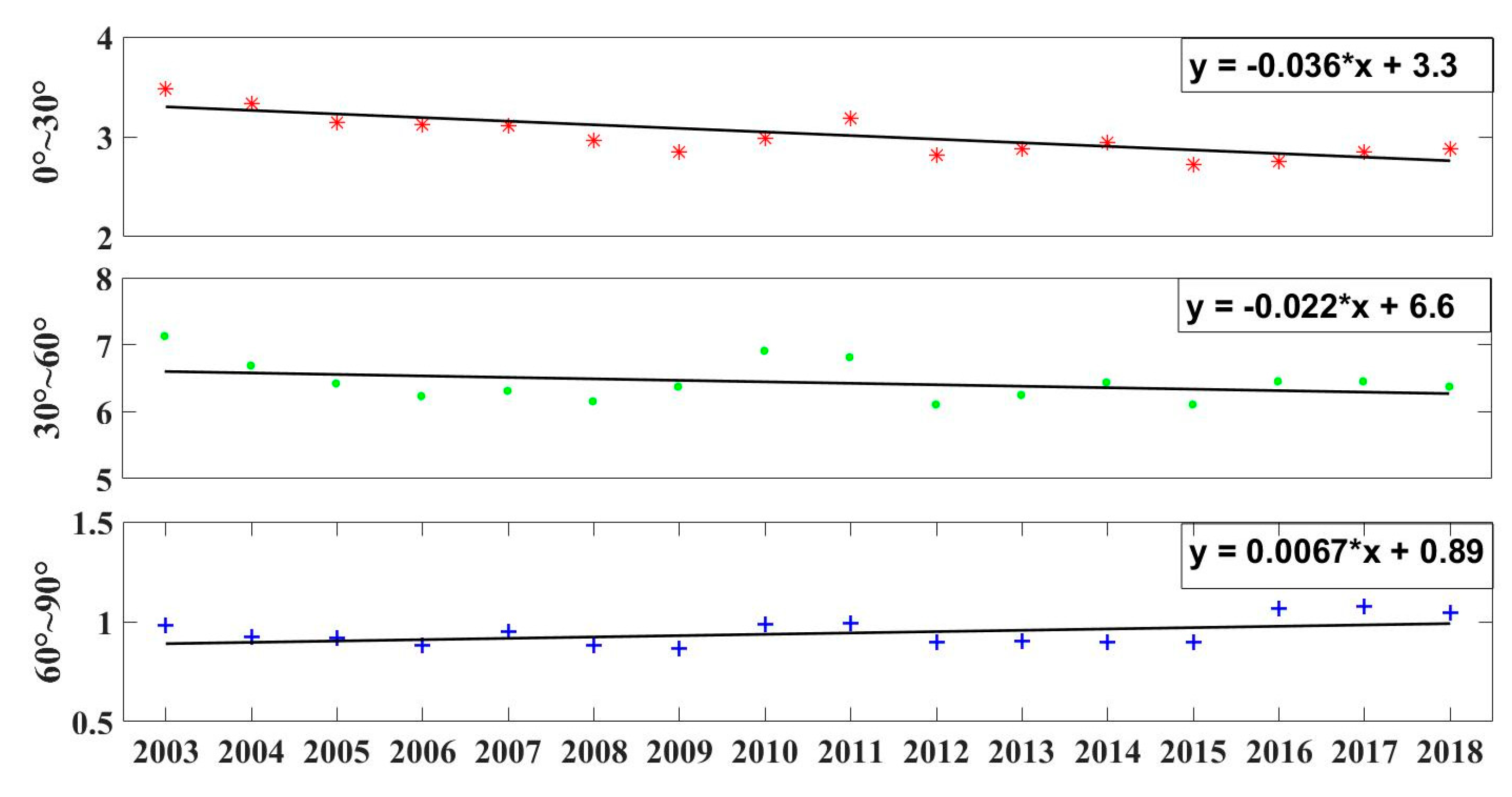
| Author | Model Expression |
|---|---|
| Baines (1994) | |
| Laws (2000) | |
| Dunne (2005a) | |
| Dunne (2005b) | |
| Henson (2011) Laws (2011a) Laws (2011b) |
| NPP Model | e-ratio Model | Bias | RMSD | uRMSD | R2 | r.e |
|---|---|---|---|---|---|---|
| SAbPM | Baines (1994) | 0.25 | 0.33 | −0.21 | 0.01 | 0.84 |
| Laws (2000) | 0.30 | 0.36 | −0.19 | 0.31 | 0.97 | |
| Dunne (2005a) | −0.01 | 0.17 | −0.17 | 0.50 | 0.30 | |
| Dunne (2005b) | 0.24 | 0.31 | −0.19 | 0.22 | 0.78 | |
| Henson (2011) | −0.27 | 0.31 | −0.16 | 0.33 | 0.50 | |
| Laws (2011a) | 0.42 | 0.45 | −0.18 | 0.16 | 1.40 | |
| Laws (2011b) | 0.33 | 0.39 | −0.21 | 0.01 | 0.84 | |
| CbPM | Baines (1994) | 0.24 | 0.34 | −0.24 | 0.09 | 0.88 |
| Laws (2000) | 0.30 | 0.37 | −0.23 | 0.23 | 1.02 | |
| Dunne (2005a) | −0.02 | 0.19 | −0.18 | 0.42 | 0.34 | |
| Dunne (2005b) | 0.23 | 0.33 | 0.24 | 0.14 | 0.85 | |
| Henson (2011) | −0.28 | 0.35 | −0.21 | 0.22 | 0.50 | |
| Laws (2011a) | 0.41 | 0.46 | −0.22 | 0.10 | 1.48 | |
| Laws (2011b) | 0.32 | 0.41 | −0.26 | 0.01 | 1.20 | |
| VGPM | Baines (1994) | −0.01 | 0.17 | −0.17 | 0.45 | 0.32 |
| Laws (2000) | 0.05 | 0.26 | 0.26 | 0.41 | 0.54 | |
| Dunne (2005a) | −0.26 | 0.36 | 0.25 | 0.47 | 0.48 | |
| Dunne (2005b) | −0.18 | 0.34 | 0.29 | 0.44 | 0.48 | |
| Henson (2011) | −0.52 | 0.56 | 0.20 | 0.39 | 0.69 | |
| Laws (2011a) | 0.13 | 0.25 | 0.21 | 0.42 | 0.54 | |
| Laws (2011b) | 0.01 | 0.18 | −0.18 | 0.42 | 0.34 |
| Estimated Sources | Global Total POC Flux (Gt C yr−1) | Instructions |
|---|---|---|
| The result of this paper | 8.5–14.3 | Dunne (2005a) |
| Laws et al., 2000 | 11.1–12.9 | Empirical algorithm of SST |
| Gnanadesikan et al., 2004 | 8.7–10 | OCMIP2 PRINCE1 |
| Schlitzer et al., 2002 | 9.6 | Nutrient inversion |
| Bopp et al., 2001 | 9.5–13.1 | COAM mode |
| Moore et al.,2002 | 7.9–12.0 | COAM(NCAR) mode |
| Henson et al.,2011 | 4 | Empirical algorithm of SST |
| Laws et al., 2011a | 13.24 | Algorithm of SST and NPP |
| Laws et al., 2011b | 9.23 | Algorithm of SST and NPP |
| Henson et al., 2015 | 8.5 | Biogeochemical model |
| Laufkötter et al., 2016 | 7.7 | Marine ecosystem models |
| Region | NPP | e-ratio | POC Flux | FPOC |
|---|---|---|---|---|
| >60°N | 3.3% | 7.14% | 8.7% | 14.6% |
| 30–60°N | 15.2% | 23.6% | 24.0% | 25.1% |
| 0–30°N | 25.3% | 11.8% | 12.7% | 24.1% |
| 0–30°S | 30.4% | 14.6% | 16.0% | 20.0% |
| 30–60°S | 25.4% | 40.0% | 37.0% | 15.4% |
| >60°S | 0.7% | 2.7% | 1.5% | 0.4% |
| Continental Margins | 18.1% | 22.9% | 29.5% | 90.1% |
| Deep Ocean | 81.9% | 77.1% | 70.5% | 9.9% |
| Total | 64.4 Pg m−2 yr1 | ——— | 11 Pg C m−2 yr−1 | 1.2 Pg C m−2 yr−1 |
© 2019 by the authors. Licensee MDPI, Basel, Switzerland. This article is an open access article distributed under the terms and conditions of the Creative Commons Attribution (CC BY) license (http://creativecommons.org/licenses/by/4.0/).
Share and Cite
Xie, F.; Tao, Z.; Zhou, X.; Lv, T.; Wang, J. Spatial and Temporal Variations of Particulate Organic Carbon Sinking Flux in Global Ocean from 2003 to 2018. Remote Sens. 2019, 11, 2941. https://doi.org/10.3390/rs11242941
Xie F, Tao Z, Zhou X, Lv T, Wang J. Spatial and Temporal Variations of Particulate Organic Carbon Sinking Flux in Global Ocean from 2003 to 2018. Remote Sensing. 2019; 11(24):2941. https://doi.org/10.3390/rs11242941
Chicago/Turabian StyleXie, Futai, Zui Tao, Xiang Zhou, Tingting Lv, and Jin Wang. 2019. "Spatial and Temporal Variations of Particulate Organic Carbon Sinking Flux in Global Ocean from 2003 to 2018" Remote Sensing 11, no. 24: 2941. https://doi.org/10.3390/rs11242941
APA StyleXie, F., Tao, Z., Zhou, X., Lv, T., & Wang, J. (2019). Spatial and Temporal Variations of Particulate Organic Carbon Sinking Flux in Global Ocean from 2003 to 2018. Remote Sensing, 11(24), 2941. https://doi.org/10.3390/rs11242941






